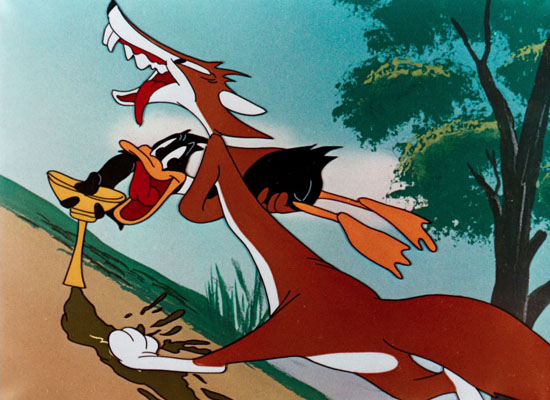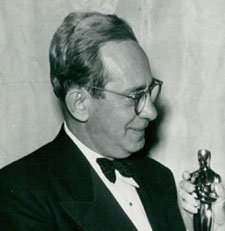
Bill Scott was born in Philadelphia on August 20,1920.
He enlisted in the Air Force in 1942 with the hopes of entering aerial photography. Through an interesting series of events, he found himself assigned to the First Motion Picture Unit in Culver City, California and was given work in an animation unit.
He began by washing cels, inbetweening, and doing layout work. He was eventually assigned to legendary Disney animator Frank Thomas’ unit, where he learned even more about animation.
 After his discharge, he became a storyman at Warner Brothers in 1946, where he worked for about a year. He worked for a variety of studios from Bob Clampett to UPA to Jay Ward.
After his discharge, he became a storyman at Warner Brothers in 1946, where he worked for about a year. He worked for a variety of studios from Bob Clampett to UPA to Jay Ward.
In the 1970s, Scott became active in ASIFA-Hollywood, the International Animated Film Society’s Hollywood branch, where he served on the Board of Directors and as President. He received an Annie Award in 1977.
Scott was well respected by his peers and was especially well known for his opinionated views on animation and the people who worked in animation. He was known for his honesty and good humor, two traits he constantly demonstrated during his many years in the business.
Bill Scott passed away on November 29, 1985 in his sleep at his home in Tujunga, California at the age of 65.
I got a chance to do a lengthy interview with him on September 3, 1982 where we spent hours talking not only about his legendary work with Jay Ward but some other things like his time at Warner Brothers and UPA. Here is a short excerpt from that interview about his year at Warners.
Jim Korkis: How did you get started at Warners after your discharge from the military?
Bill Scott: I kicked around for a while. I went to Rudy Ising (who Scott had worked with in the Motion Picture Unit) looking for work. Rudy said he’d try to find something for me, but nothing opened up. Then I got a call from Warners. Bob Clampett had left a short time before, and they had promoted an animator named Art Davis to the post of director. They were looking for new storymen for this unit, so they hired a fellow named Lloyd Turner and me.
JK: Were you and Turner a story team?
BS: We worked together as a team for a year. We didn’t know it, but we were working in competition with each other. At the end of the year, we found ourselves put off on our own. We each had to write our own story, and whoever had the better story would be kept on and the other guy would be fired. This is what I called the “Fang and Claw System”.
JK: That must have made things difficult for the both of you.
BS: It would have, except that we refused to play the game. We worked on each other’s stories. We just worked double-time, that’s all. Where we would normally do one story in six weeks, we did two stories in six weeks. All the jokes were joint jokes, exactly the way we’d done it before. We tossed a coin to see whose story would be whose. When the two stories were done, they liked Lloyd’s story better than the one I had supposedly written by myself. He was kept on and I was fired.
JK: What were some of the shorts you and Turner worked together on at Warners?
 BS: “Doggone Cats” (1947) about the cats preventing the dog from delivering the package to Uncle Louie was ours. One I really remember was “What Makes Daffy Duck?” (1948) where Elmer and a fox are both hunting Daffy. “Bone Sweet Bone” (1948). I’d forgotten that completely. “Riff Raff Daffy” (1948), “A Hick, A Slick, and A Chick” (1948), “Two Gophers from Texas” (1948)–that was the one with the two Goofy Gophers. I also remember us doing some work on “Catch as Cats Can” (1947) and “Mexican Joyride” (1947).
BS: “Doggone Cats” (1947) about the cats preventing the dog from delivering the package to Uncle Louie was ours. One I really remember was “What Makes Daffy Duck?” (1948) where Elmer and a fox are both hunting Daffy. “Bone Sweet Bone” (1948). I’d forgotten that completely. “Riff Raff Daffy” (1948), “A Hick, A Slick, and A Chick” (1948), “Two Gophers from Texas” (1948)–that was the one with the two Goofy Gophers. I also remember us doing some work on “Catch as Cats Can” (1947) and “Mexican Joyride” (1947).
JK: Other than the fact that you suddenly found yourself working in competition with Turner, did you enjoy working at Warners?
BS: Of course. I was working with my heroes. They were all guys I’d heard about for so long. As far as I was concerned, they were the greatest writers in the business: names like Mike Maltese, Tedd Pierce, and Warren Foster. They all turned out to be very nice guys, every one of them. Warren Foster was the squarest of them, and he spent half his time playing the horses. I think he was the hardest worker.
JK: I know Maltese was teamed with Tedd Pierce at this time.
BS: You couldn’t get two funnier people going through a storyboard than Maltese and Pierce. Pierce was a very good looking man. He really had a patrician look to him when he wasn’t bruised. He used to get in a lot of fights off the lot for a variety of reasons. On Mondays he would sometimes show up looking like death warmed over, or he wouldn’t show up at all. He had a fine New England accent, and he was a tremendous guy, a very funny fellow.
JK: Do you think the background you had in animation during the war helped you as a storyman?
BS: Of course. A good animation writer needs to have an awareness of the medium, what is capable of being done. It’s also useful to know how to draw. It’s not vital. There are some writers who can’t draw worth a darn but it is easier to sketch out little stick figures than type a page and half of instructions and directions. I couldn’t draw worth a pinch but I was good enough to draw these funny ideas about situations and would drop them on people’s desks and they’d just laugh and laugh and pass them around. I think that was why I got recommended to be a storyman at Warners.
JK: Is there one memory about working at Warners that sticks out for you?
BS: The time clock that was at the front of the door. It seemed like a long, long hall in a long, long building. I guess there were a hundred people or more working there at the time, and everybody always wanted to be the first to punch out. Otherwise, you had to stand in this damned line forever waiting to punch out. Well, about 4:45 pm the infiltration would start to get to the clock. If you were in the hall, you’d be sent back to your room, or the boss, Eddie Selzer, would call you in and bawl you out or possibly dock your salary.
JK: So there was an element of danger?
BS: Definitely. The infiltration would start from the second floor. We’d go down the steps, then a quick dart across the hall into McKimson’s unit’s room. Then we’d peek out and if there was no one there, we’d work our way to the ink and paint department. so this whole thing looks like a group of commandos trying to get to the time clock. And then when the big bell on the clock went off, the hall was instantly filled. People were racing down to be the first one to punch out. I used to just laugh my fool head off watching these serious people with all these secret strategies. People were afraid that Selzer might come walking down the hall, so you had to be prepared to hide inside rooms. There were people crouching behind desks, inside closets, and heaven only knows what else. It was a crazy time.
 JK: Chuck Jones always seemed to make Eddie Selzer (pictured, left), producer of Warner Bros. cartoons from 1944 to 1957, the “villain” in his stories about working at Warners.
JK: Chuck Jones always seemed to make Eddie Selzer (pictured, left), producer of Warner Bros. cartoons from 1944 to 1957, the “villain” in his stories about working at Warners.
BS: He was a man who never should have been there, but they couldn’t find anything else for him to do on the main lot so they made him head of cartoons. He was a mean SOB with no sense of humor. I’ve been told that after his retirement, he turned out to be a much nicer fellow. But while I was there, he was the heavy, the bad guy. There was no doubt about it. He’d scare the pants off me all the time.
JK: Is there a Selzer story that sticks in your mind?
BS: My favorite Selzer story happened when I was not there. Lloyd and I were working in the same room and had pinned up a little piece of cardboard on our door that said: “Bill Scott and Lloyd Turner: Story”. I was fired on a Friday and on Monday Selzer came walking down the hall and saw the sign was still there. He poked his head in the doorway and said to Lloyd, “Why don’t you take that sign off the door?” Lloyd asked why, and Selzer replied, “Scott isn’t here any more, and you’re not good enough to have your name on the door!” Now, it was unnecessary to handle the situation in that way. He was just throwing his weight around. He was a mean little man.


 Jim Korkis is an internationally respected animation historian who in recent years has devoted his attention to the many worlds of Disney. He was a columnist for a variety of animation magazines. With his former writing partner, John Cawley, he authored several animation related books including The Encyclopedia of Cartoon Superstars, How to Create Animation, Cartoon Confidential and Get Animated’s Animation Art Buyer’s Guide. He taught animation classes at the Disney Institute in Florida as well as instructing classes on acting and animation history for Disney Feature Animation: Florida.
Jim Korkis is an internationally respected animation historian who in recent years has devoted his attention to the many worlds of Disney. He was a columnist for a variety of animation magazines. With his former writing partner, John Cawley, he authored several animation related books including The Encyclopedia of Cartoon Superstars, How to Create Animation, Cartoon Confidential and Get Animated’s Animation Art Buyer’s Guide. He taught animation classes at the Disney Institute in Florida as well as instructing classes on acting and animation history for Disney Feature Animation: Florida.




















































Great entry, Jim. Thanks.
Despite his high profile work, Bill Scott seems something of a forgotten man.
Brawling Tedd Pierce, huh? Interesting tidbit.
Excellent piece to share. I referred to Jim’s interview while writing THE MOOSE THAT ROARED. I hope Jim can eventually piece together some of his Bob Clampett talks. Incidentally, Paul Etcheverry also did an extensive chat with Scott, who proved an excellent subject when it came to recall.
Great story. I made Eddie Selzer a character in my cartoon series.